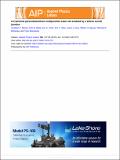| dc.contributor.author | Mailoa, Jonathan P. | |
| dc.contributor.author | Bailie, Colin D. | |
| dc.contributor.author | Johlin, Eric Carl | |
| dc.contributor.author | Hoke, Eric T. | |
| dc.contributor.author | Akey, Austin J. | |
| dc.contributor.author | Nguyen, William H. | |
| dc.contributor.author | McGehee, Michael D. | |
| dc.contributor.author | Buonassisi, Tonio | |
| dc.date.accessioned | 2015-03-27T15:09:07Z | |
| dc.date.available | 2015-03-27T15:09:07Z | |
| dc.date.issued | 2015-03 | |
| dc.date.submitted | 2015-02 | |
| dc.identifier.issn | 0003-6951 | |
| dc.identifier.issn | 1077-3118 | |
| dc.identifier.uri | http://hdl.handle.net/1721.1/96207 | |
| dc.description.abstract | With the advent of efficient high-bandgap metal-halide perovskite photovoltaics, an opportunity exists to make perovskite/silicon tandem solar cells. We fabricate a monolithic tandem by developing a silicon-based interband tunnel junction that facilitates majority-carrier charge recombination between the perovskite and silicon sub-cells. We demonstrate a 1 cm[superscript 2] 2-terminal monolithic perovskite/silicon multijunction solar cell with a V [subscript OC] as high as 1.65 V. We achieve a stable 13.7% power conversion efficiency with the perovskite as the current-limiting sub-cell, and identify key challenges for this device architecture to reach efficiencies over 25%. | en_US |
| dc.description.sponsorship | Bay Area Photovoltaic Consortium (Contract DE-EE0004946) | en_US |
| dc.description.sponsorship | United States. Dept. of Energy (Contract DE-EE0006707) | en_US |
| dc.language.iso | en_US | |
| dc.publisher | American Institute of Physics (AIP) | en_US |
| dc.relation.isversionof | http://dx.doi.org/10.1063/1.4914179 | en_US |
| dc.rights | Article is made available in accordance with the publisher's policy and may be subject to US copyright law. Please refer to the publisher's site for terms of use. | en_US |
| dc.source | Mailoa | en_US |
| dc.title | A 2-terminal perovskite/silicon multijunction solar cell enabled by a silicon tunnel junction | en_US |
| dc.type | Article | en_US |
| dc.identifier.citation | Mailoa, Jonathan P. et al. “A 2-Terminal Perovskite/silicon Multijunction Solar Cell Enabled by a Silicon Tunnel Junction.” Applied Physics Letters 106.12 (2015): 121105. © 2015 AIP Publishing LLC | en_US |
| dc.contributor.department | Massachusetts Institute of Technology. Department of Electrical Engineering and Computer Science | en_US |
| dc.contributor.department | Massachusetts Institute of Technology. Department of Mechanical Engineering | en_US |
| dc.contributor.department | Massachusetts Institute of Technology. Laboratory for Manufacturing and Productivity | en_US |
| dc.contributor.mitauthor | Mailoa, Jonathan P. | en_US |
| dc.contributor.mitauthor | Johlin, Eric Carl | en_US |
| dc.contributor.mitauthor | Akey, Austin J. | en_US |
| dc.contributor.mitauthor | Buonassisi, Tonio | en_US |
| dc.relation.journal | Applied Physics Letters | en_US |
| dc.eprint.version | Final published version | en_US |
| dc.type.uri | http://purl.org/eprint/type/JournalArticle | en_US |
| eprint.status | http://purl.org/eprint/status/PeerReviewed | en_US |
| dspace.orderedauthors | Mailoa, Jonathan P.; Bailie, Colin D.; Johlin, Eric C.; Hoke, Eric T.; Akey, Austin J.; Nguyen, William H.; McGehee, Michael D.; Buonassisi, Tonio | en_US |
| dc.identifier.orcid | https://orcid.org/0000-0003-2239-6192 | |
| dc.identifier.orcid | https://orcid.org/0000-0001-8345-4937 | |
| dspace.mitauthor.error | true | |
| mit.license | PUBLISHER_POLICY | en_US |
| mit.metadata.status | Complete | |
